Wheat allergy is an allergic reaction caused by the immune system in response to any of the proteins present in wheat. When a person with a wheat allergy consumes wheat products, in some cases, inhales wheat flour, their body perceives the wheat as a threat and sends out antibodies to attack it. This response can cause many symptoms, some of which are life-threatening. Wheat allergy is often confused with celiac disease, but both of them differ in their symptoms and diagnosis.

Symptoms
The symptoms of wheat allergy emerge in a few minutes of coming into contact with wheat or its derivatives. These symptoms include:
- Itchy rashes, swelling or hives on patient’s skin
- Nausea or vomiting
- Irritation in the eyes
- Congestion in the nasal passage
- Irritation and/or swelling in the mouth or throat of the patient
- Diarrhea
- Headache
- Anaphylaxis: Life-threatening allergic reaction occurring in some patients is known as anaphylaxis. Anaphylaxis may cause severe breathing problems, pale or blue skin color, syncope episodes, chest pain, swelling in the throat, and trouble in swallowing.
People allergic to wheat adhere to a more wheat-free lifestyle, symptoms, as well as the problems arising due to allergy, can be easily resolved. These symptoms can also be managed by certain medications, which can also assist if the person accidentally eats wheat or its derivatives.
Causes
If you are allergic to wheat, any exposure to the proteins present in wheat will cause an immune response in your body. You can develop an allergy to any of these four classes of wheat proteins - globulin, albumin, gluten, and gliadin.
Some common sources of wheat proteins that are capable of triggering an allergic reaction in people with wheat allergy are:
- Bread crumbs and bread
- Pasta
- Farina
- Semolina
- Soy Sauce
- Hot-dogs and cold cuts
- Breakfast cereals
- Cakes, cookies, and muffins
- Couscous
- Crackers
- Ice cream and natural flavorings
- Gelatinized and modified food starch
- Vegetable gum
- Breaded or crusted protein
- Licorice, hard candies and jelly beans
- Beer
People with this allergy are prone to developing an allergy to oats, barley, and rye.
It has been observed that symptoms in some people only occur while exercising after the consumption of wheat products. These symptoms are much more complex, severe than the normal ones and may include anaphylaxis. Such a condition is called wheat-dependent exercise-induced anaphylaxis.
Treatment
One of the best treatments recommended by physicians all over the world is adhering to a strict wheat-free diet for avoiding symptoms. Such people should be using one or more from many alternatives to wheat present in the market. They can consume fresh fruits, vegetables, beans, and meat and products marked gluten-free are free from wheat, hence won’t induce the symptoms.
Grains such as corn, quinoa, rice, barley, oats, and rye can be consumed in place of wheat. Traditional flour can be replaced with soy, rice, corn, tapioca, potato, coconut, sorghum, millets, or mixtures of them excluding wheat. Consumable products that contain derivatives of wheat or whole wheat have clear labels on their packs so that people allergic to wheat can avoid their accidental consumption or purchase.
People with this allergy having anaphylaxis experience serious symptoms within minutes of consumption of wheat. As per medical resources, these symptoms can be immediately treated through injecting epinephrine, which is a steroid.
Some of the common allergy symptoms can be treated through physicians-recommended medications like using antihistamines and corticosteroids. Symptoms of the allergy may be extensively annoying, but people eventually cope up with adopting a wheat-free lifestyle, although all-time proper preparation is required for anaphylaxis.
Disclaimer: The information in no way constitutes, or should be construed as medical advice. Nor is the above article an endorsement of any research findings discussed in the article an endorsement for any of the source publications.








